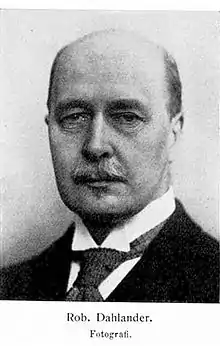A Dahlander motor (also known as a pole changing motor, dual- or two speed-motor) is a type of multispeed three-phase induction motor, in which the speed of the motor is varied by altering the number of poles; this is achieved by altering the wiring connections inside the motor. The motor may have fixed or variable torque depending on the stator winding. It is named after its inventor Robert Dahlander (1870–1935).[1][2]
Invention

Robert Dahlander, a Swedish engineer working for ASEA,[3] discovered that switching the poles in a motor led to a reduction in the speed of the motor. In 1897 he invented an electrical configuration to switch between poles in a motor for which he was granted a patent along with his co-worker Karl Arvid Lindström. The new connection was named the "Dahlander connection" and a motor having such a configuration is commonly referred to as a "pole changing motor" or a "Dahlander motor".[4][5]
Operation

The Dahlander motor is based on a 'consequent pole' connection. The primary factor in determining the speed of an induction motor is the number of poles, given by the formula
- (RPM)
where
- ns = Synchronous speed, in revolutions per minute
- f = AC power frequency
- p = Number of poles per phase winding[6]
A regular induction motor has an equal number of opposite poles; that is, at any instant, there are an equal number of North and South magnetic poles. Some smaller induction motors are connected so that all the poles are identical, causing the motor to act as though there is an equal number of opposite poles in between.
A Dahlander motor achieves different speeds by switching the configuration of the electrical windings, indirectly adding or removing poles and thus varying the rotor speed. The poles can be varied at a ratio of 1:2 and thus the speed can be varied at 2:1.[7][8][9] Normally, the electrical configuration of windings is varied from a delta connection (Δ) to a double star connection (YY) configuration in order to change the speed of the motor for constant torque applications, such as the hoists in cranes.[7][8][9] Star connections (Y) varied to double star connections (YY) are used for quadratic torque applications, such as pumps.[7][9]
Advantages and disadvantages
Dahlander motors have advantages compared to other speed control systems like variable frequency drives, as there is less power loss. This is because most of the power is used to drive the motor and no electrical pulse switching is done. The system is much simpler and easier to use compared to other speed control methods available. However, the Dahlander motor has the disadvantage of fast mechanical wear and tear due to changing speeds in such a drastic ratio; this type of connection also produces high harmonic distortion during the shifting of poles as the angular distance between the power generated increases as the poles are decreased in the motor.[9]
Application
Pole changing motors are normally used in applications where two speed controls are necessary. Some typical applications are:[10][11]
See also
References
- ↑ US 725415
- ↑ Heilbronner, Friedrich; Jäger, Kurt (2010). Lexikon der Elektrotechniker (in German) (2 ed.). Germany: VDE-Verlag. p. 93. ISBN 978-3-8007-2903-6.
- ↑ "Robert Dahlander". Dictionary of Swedish National Biography (in Swedish). Riksarkivet (National Archives of Sweden. Retrieved 12 December 2014.
- ↑ US 725415, CH 14112
- ↑ DE 98417Arrangement for obtaining two different pole numbers for asynchronous AC motors, 11 February 1897
- ↑ Eitel, Elisabeth (1 April 2012). "The difference between AC induction, permanent magnet, and servomotor technologies". Machine Design. Retrieved 21 June 2015.
- 1 2 3 Boy, Günter; Flachmann, Horst (1983). Die Meisterprüfung Elektrische Maschinen und Steuerungstechnik (in German) (4 ed.). Wurzburg, Germany: Vogel-Verlag. p. 25. ISBN 3-8023-0725-9.
- 1 2 Jufer, Marcel (2013). Electric Drive: Design Methodology. John Wiley & Sons. p. 48. ISBN 978-1118621592.
- 1 2 3 4 Toliyat, Hamid A.; Kliman, Gerald B., eds. (2004). Handbook of Electric Motors (2nd ed.). CRC Press. pp. 234–236. ISBN 1420030388.
- ↑ Deshpande, M.V (2010). Design And Testing Of Electrical Machines (1 ed.). India: PHI learning pvt ltd. p. 434. ISBN 978-81-203-3645-2.
- ↑ "Dahlander motor". Archived from the original on 28 April 2015. Retrieved 9 December 2014.